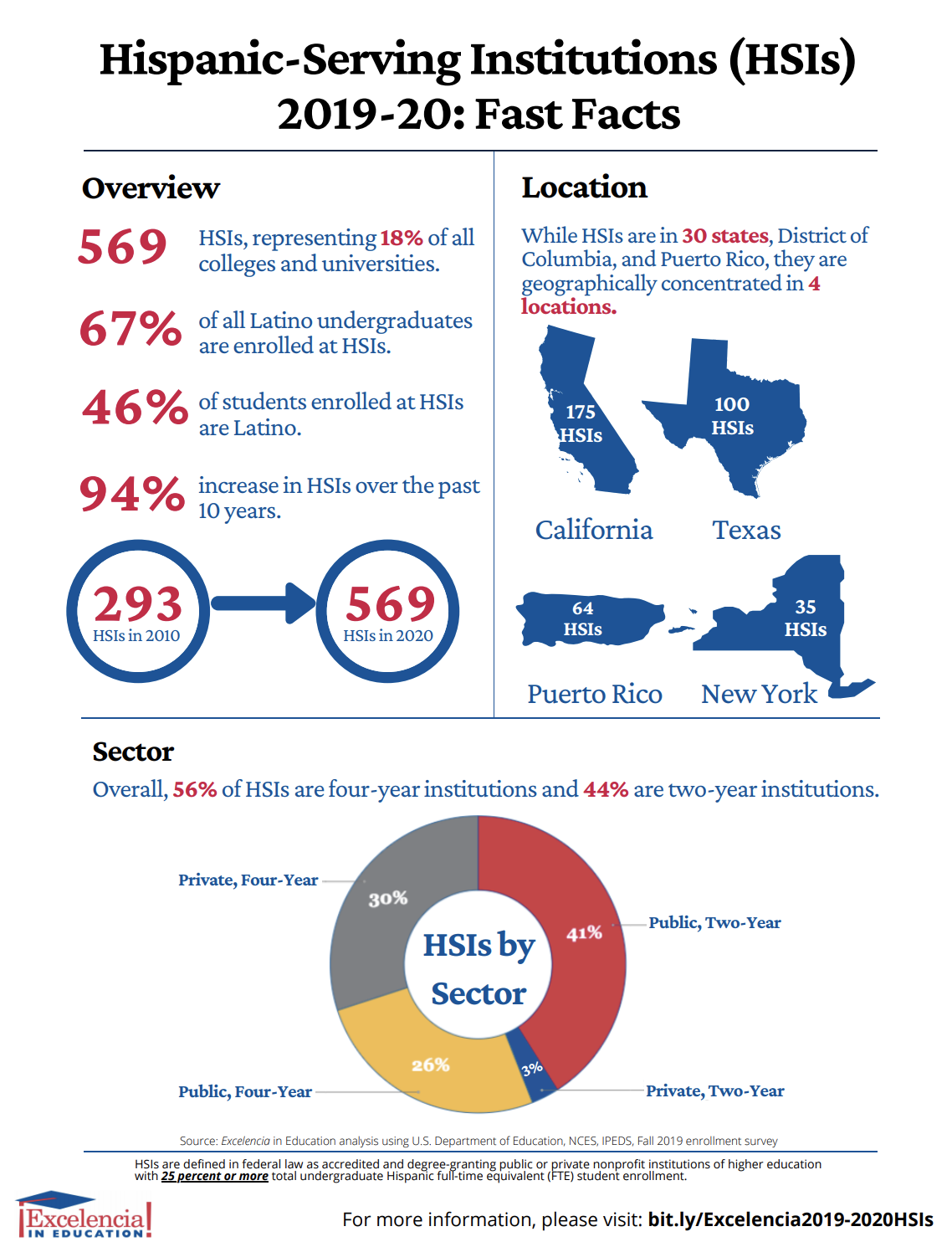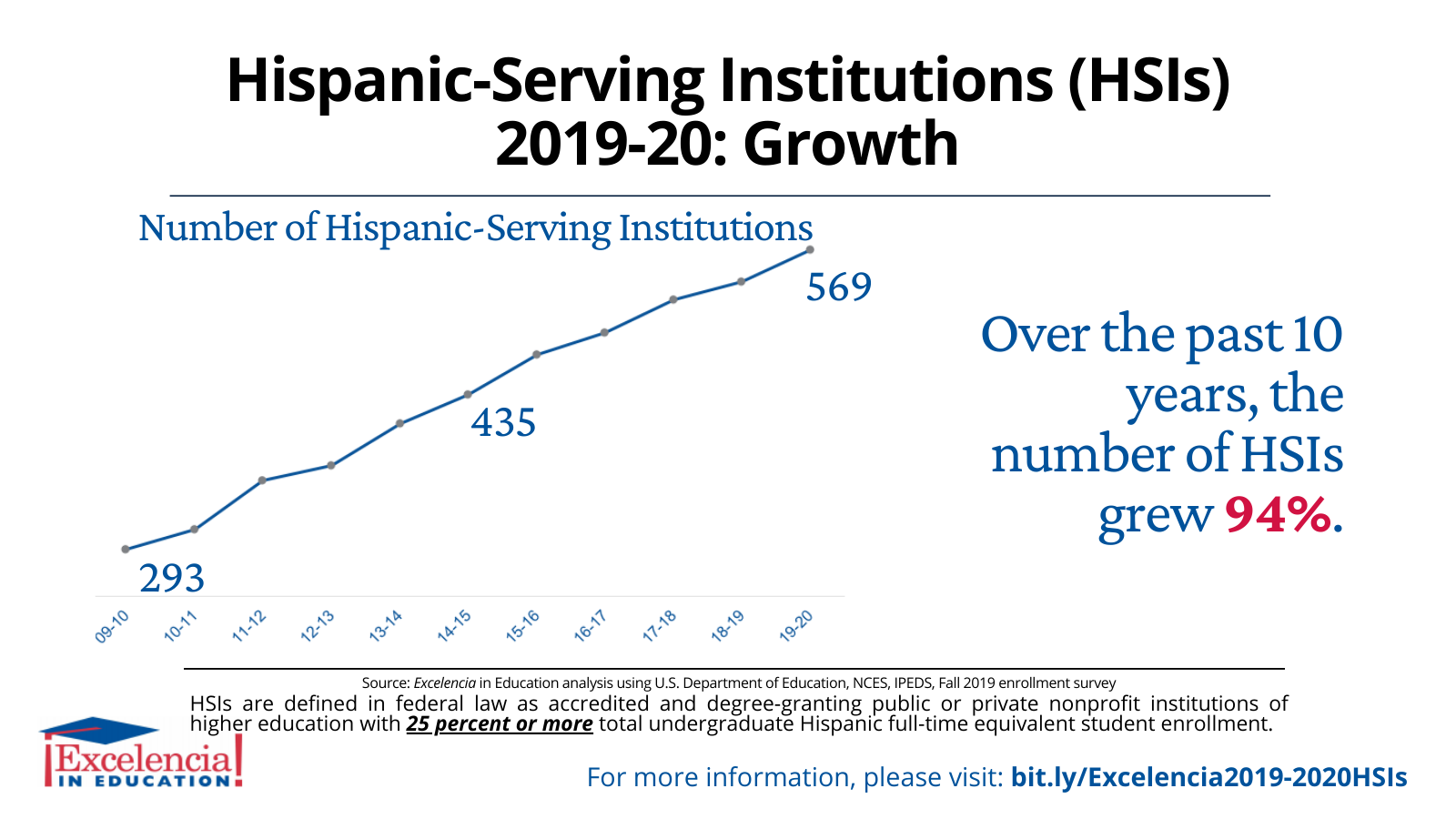
Share On Social!
The number of Latino or Hispanic-serving colleges and universities has risen 94% in the past 10 years, from 293 in 2010 to 569 in 2020, according to a new data report by Excelencia in Education.
A “Hispanic-Serving Institution” (HSI) has 25% or more undergraduate full-time equivalent Latino enrollment.
HSIs now constitute 18% of all colleges and universities. This is up from 17% in 2018.
On top of that, Latino enrollment in higher education is expected to exceed 4.4 million students by 2025, far surpassing the growth rate of any other racial-ethnic group, according to the Hispanic Association of Colleges and Universities.
“Educating Latino students is now a necessity. More has to be done to achieve the institutional transformation that intentionally serves Latinos, who are the country’s largest and youngest ethnic demographic and the key to our future workforce and civic leaders,” said Deborah Santiago, leader of Excelencia in Education, in a statement.
The Key Data on Hispanic-Serving Institutions
 Here are some facts from Excelencia in Education:
Here are some facts from Excelencia in Education:
- Two of three Latino undergraduates attend an HSI (67%). That includes 1.49 million students.
- 46% of student enrollment at HSIs is Latino.
- HSIs are present in 30 states and Puerto Rico. That’s up from 27 in 2018.
- HSIs are very concentrated geographically. 69% were located in three states and Puerto Rico. California has the most (175 HSIs), followed by Texas (100) and New York (35).
- Most HSIs are located in a city (54%). Fewer are in towns (30%), rural areas (9%), or suburbs (7%).
- Most HSIs are public four-year colleges or universities (30% private and 26% public). The rest are public or private two-year institutions.
- 42% of HSIs offer graduate degrees.
- There are 362 “Emerging HSIs” with 15-24.9% Latino enrollment.
“While emerging HSIs do not have the critical mass of Latino student enrollment required to meet the definition of an HSI, these institutions may soon meet the criteria as their enrollment grows and Latino representation increases,” according to the report.
Implications of the Data on Hispanic-Serving Institutions
This data is important given Latinos’ struggles in higher education.
Latino college students are far less likely than their white peers to complete their degree. They are more likely to still be enrolled beyond six years on their path to a degree.
Latinos also are not getting their fair share of seats or degrees from public institutions of higher education in nearly every state when compared with state demographics and White peers, according to recent research.
 Why is this inequity happening?
Why is this inequity happening?
It’s not about a lack of talent or aspirations among Latinos—it’s the result of “structural racism and injustices throughout the education pipeline” that make it harder to pursue high education, according to the report.
“A college degree is the surest path to the middle class. The fact that Latinos don’t have equitable access to enrolling in college and earning a college degree means millions of Latinos are missing out on the best chance to move into the middle class,” said Wil Del Pilar of The Education Trust, in a news release. “This isn’t just damaging to Latinos. This systematic inequality threatens our democracy and our economy. It’s time for state leaders to act.”
Choosing the right college does make a difference.
“Latinos make up 18% of the U.S. population but just 8.5% of students at selective institutions, the very places that have more resources to help students cross the finish line,” according to the Education Trust. “Students who attend these colleges and universities are more likely to complete their degrees.”
Actions to Boost Latino College Enrollment, Graduation in Hispanic-Serving Institutions and Beyond
The Education Trust calls on states to act to understand the root causes of Latino enrollment and degree disparities.
They recommend these four immediate actions:
- Set race and ethnicity targets in statewide college degree attainment goals.
- Reward public colleges and universities for enrolling and graduating students of color.
- Ensure residents with some college but no degree are eligible for need-based aid programs.
- Invest in community college programs that help residents earn high school equivalency credentials and get on a pathway to higher education.
 “For starters, every state in the country should set measurable race and ethnicity targets as part of statewide college degree attainment goals,” Del Pilar said. “States should reward colleges for enrolling and graduating students of color in performance funding formulas.”
“For starters, every state in the country should set measurable race and ethnicity targets as part of statewide college degree attainment goals,” Del Pilar said. “States should reward colleges for enrolling and graduating students of color in performance funding formulas.”
Other Ways to Support Latino Students and Improve Hispanic-Serving Institutions
Here are some other ways to help:
- Support Hispanic-Serving Institutions, which are on the rise.
- Offer a short task with the power to sharply increase Latino middle-schoolers’ chances of getting to college.
- Provide college for Latino students who don’t have a high-school diploma.
- Create college readiness programs in high school.
- Recognize colleges that are committed and able to help Latino students find success.
Del Pilar and others suggest states invest in community college programs that help residents earn a high school equivalency credential and get on a pathway to higher education.
“States must do better in serving Latino students when it comes to access and success in public higher education,” said Arturo Vargas, Chief Executive Officer of NALEO Educational Fund. “NALEO Educational Fund will continue to work towards this goal by supporting Latino elected and appointed officials as they develop and enact policies to improve academic opportunity and success among our community.”
Excelencia in Education also keeps a “what works” database of programs that help Latino students.
They list Éxito! Latino Cancer Research Leadership Training, led by Salud America! director Dr. Amelie G. Ramirez of UT Health San Antonio, as a program to watch.
Éxito! recruits 25 Latino students annually for a culturally tailored curriculum to promote pursuit of a doctoral degree and cancer research career.
“Institutions of higher education have an opportunity to combine data, practice, and leadership to accelerate Latino student success,” according to Excelencia in Education. “They ensure that Latino students graduate college and become agents of change for their communities and for the nation.”
Explore More:
EducationBy The Numbers
142
Percent
Expected rise in Latino cancer cases in coming years



